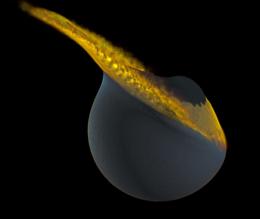Collision with lost second satellite would explain Moon's asymmetry.

A previous collision with a smaller companion could explain why the Moon's two sides look so different.Martin Jutzi and Erik Asphaug
Earth once had two moons, which merged in a slow-motion collision that took several hours to complete, researchers propose in Nature today.
Both satellites would have formed from debris that was ejected when a Mars-size protoplanet smacked into Earth late in its formation period. Whereas traditional theory states that the infant Moon rapidly swept up any rivals or gravitationally ejected them into interstellar space, the new theory suggests that one body survived, parked in a gravitationally stable point in the Earth–Moon system.
Several such 'Lagrangian' points exist, but the two most stable are in the Moon's orbit, 60° in front or 60° behind.
Traces of this 'other' moon linger in a mysterious dichotomy between the Moon's visible side and its remote farside, says Erik Asphaug, a planetary scientist at the University of California, Santa Cruz, who co-authored the study with Martin Jutzi, now of the University of Berne
.
The Moon's visible side is dominated by low-lying lava plains, whereas its farside is composed of highlands. But the contrast is more than skin deep. The crust on the farside is 50 kilometres thicker than that on the nearside.
The nearside is also richer in potassium (K), rare-earth elements (REE) and phosphorus (P) — components collectively known as KREEP. Crust-forming models show that these would have been concentrated in the last remnants of subsurface magma to crystallize as the Moon cooled.
What this suggests, Asphaug says, is that something 'squished' the late-solidifying KREEP layer to one side of the Moon, well after the rest of the crust had solidified. An impact, he believes, is the most likely explanation.
"By definition, a big collision occurs only on one side," he says, "and unless it globally melts the planet, it creates an asymmetry."
“Why the nearside of the Moon looks so different to the farside has been a puzzle since the dawn of the space age.”
Francis Nimmo
University of California, Santa Cruz
University of California, Santa Cruz
Such a moon could have survived in a Lagrangian point long enough for its upper crust and that of the Moon to solidify, even as the Moon's deeper KREEP layer remained liquid.
Meanwhile, tidal forces from Earth would have been causing both moons to migrate outward. When they reached about one-third of the Moon's present distance (a process that would take tens of millions of years), the Sun's gravity would have become a player in their orbital dynamics.
"The Lagrange points become unstable and anything trapped there is adrift," Asphaug says. Soon after, the two moons collided. But because they were in the same orbit, the collision was at a relatively low speed.
"It's not a typical cratering event, where you fire a 'bullet' and excavate a crater much larger than the bullet," Asphaug says. "Here, you make a crater only about one-fifth the volume of the impactor, and the impactor just kind of splats into the cavity."
Like a pancake
In the hours after the impact, gravity would have crushed the impactor to a relatively thin layer, pasted on top of the Moon's existing crust. "You end up with a pancake," Asphaug says. The impact would have pushed the still-liquid KREEP layer to the Moon's opposite side.Apshaug's theory isn't the only attempt to explain the lunar dichotomy. Others have invoked tidal effects from Earth's gravity, or convective forces from cooling rocks in the Moon's mantle.
"The fact that the nearside of the Moon looks so different to the farside has been a puzzle since the dawn of the space age," says Francis Nimmo, one of the authors of a 2010 paper in Science proposing tidal forces as the cause .But despite his competing model, Nimmo (a colleague of Asphaug's at Santa Cruz, but not an author of the new study) calls the new theory "elegant".
No comments:
Post a Comment
Note: only a member of this blog may post a comment.